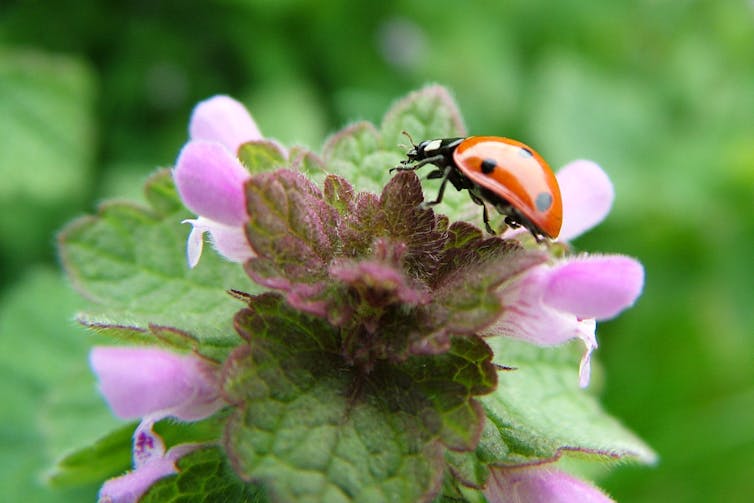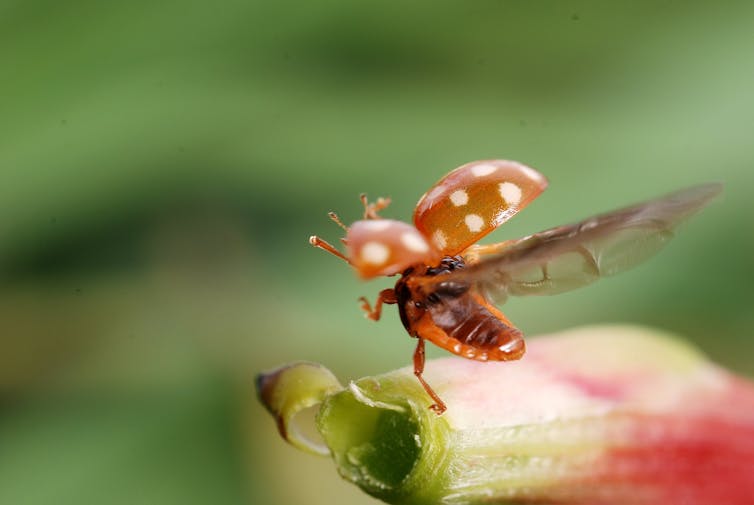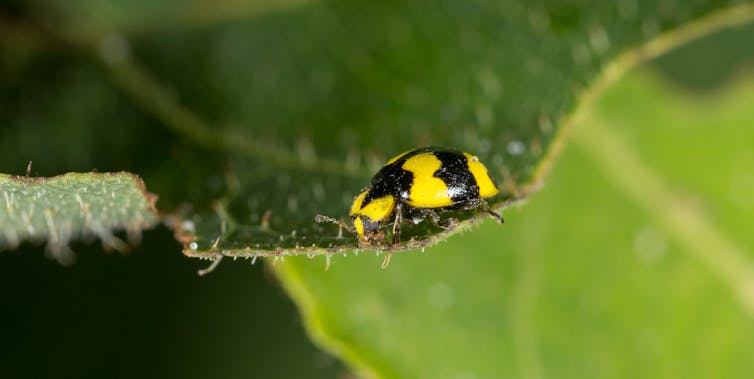Curious Kids: why don't ladybirds have tails?
- Written by Heshani Edirisinghe, PhD student, Massey University
Curious Kids is a series for children. If you have a question you’d like an expert to answer, send it to curiouskids@theconversation.edu.au You might also like the podcast Imagine This, a co-production between ABC KIDS listen and The Conversation, based on Curious Kids.
Why don’t ladybirds have tails? – Lotte, aged 2.
Thank you, Lotte, for this great question.
Let’s start by thinking about animals that do have tails and what they have in common.
Dogs, elephants, cats, birds, monkeys, and fish – they all have tails and use them for many different things like balancing, swishing flies away, or hanging onto things. And what do all these animals have in common? A backbone!
That’s because a tail is actually an extension of a backbone. (Humans used to have tails! Our early ancestors did but then we changed over time and now only a little stump of a “tailbone” remains.)
So to answer your question, ladybirds do not have tails because they do not have a backbone.
They have something called an “exoskeleton” instead. I will explain what that word means.
 An exoskeleton means an outside skeleton.
nino**/flickr, CC BY-NC-ND
An exoskeleton means an outside skeleton.
nino**/flickr, CC BY-NC-ND
Insects have their skeletons on the outside
Exoskeleton means a skeleton that is on the outside. And ladybirds are a type of insect – just like beetles, bees, stick insects, and flies.
An insect’s exoskeleton is a hard outer shell that protects important stuff on the inside of their body (like its stomach, and special tubes that help it breathe).
 Ladybirds, like other insects, have their skeletons on the outside of their body.
___steph___/flickr, CC BY-NC-ND
Ladybirds, like other insects, have their skeletons on the outside of their body.
___steph___/flickr, CC BY-NC-ND
Parts of the ladybird body
A ladybird’s body is divided into three sections: a head, a thorax, and an abdomen.
The head has eyes, mouthparts, and antennae. Antennae help them sense what’s in front of them and how far away it is.
The thorax is where all the legs and wings are connected to the body. Ladybirds have six legs and two pairs of wings.
The tough pair of outer wings is tough is called the “elytra”. The second pair is hidden underneath and ladybirds stretch these wings out only when they need to fly.
 A ladybird in flight.
Gilles San Martin/flickr, CC BY-NC-ND
A ladybird in flight.
Gilles San Martin/flickr, CC BY-NC-ND
Bright colour means ‘don’t touch!’
Ladybirds come in red, orange, yellow, blue, brown, and black. Most of them have black dots or patterns on them.
We think that ladybirds use their colours to warn other animals (like birds or spiders) to not to eat them. They’re using their bright colour to send a message that says “Hey! I taste bad, so don’t eat me!”
Their predators recognise what these colours mean and avoid eating them.
Ladybirds are beautiful and smart, aren’t they?
 The ladybird’s bright yellow colour warns other animals not to eat them.
Graham Wise/flickr
The ladybird’s bright yellow colour warns other animals not to eat them.
Graham Wise/flickr
Read more: In red and black, the genetics of ladybug spots
Hello, curious kids! Have you got a question you’d like an expert to answer? Ask an adult to send your question to curiouskids@theconversation.edu.au
 CC BY-ND
Please tell us your name, age and which city you live in. We won’t be able to answer every question but we will do our best.
CC BY-ND
Please tell us your name, age and which city you live in. We won’t be able to answer every question but we will do our best.
Authors: Heshani Edirisinghe, PhD student, Massey University
Read more http://theconversation.com/curious-kids-why-dont-ladybirds-have-tails-117749



